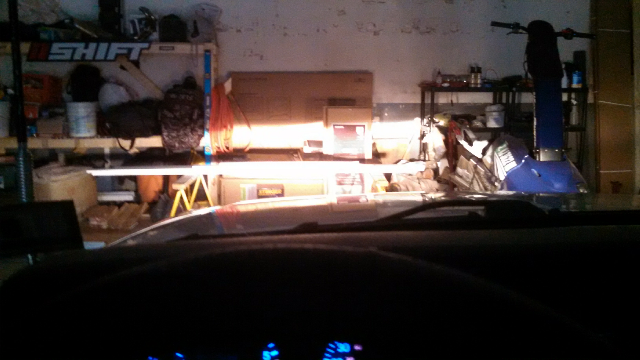Headlights
#1
Senior Member
Thread Starter
Join Date: Mar 2012
Location: Racine, WI
Posts: 974
Likes: 0
Received 8 Likes
on
7 Posts
Year: 1997
Model: Cherokee
Engine: 4.0
Headlights
I've been seeing a lot of posts asking about headlights lately, and a lot of people making bad choices without even knowing what they're doing wrong. There is a lot of really good information out there, but most people don't have the time, skill, or discipline to research for themselves. The following is my attempt to gather information on the topic together into one place in the hopes that people will find this post and be able to answer their own questions. If that doesn't work, at least I'll have something of my own to quote instead of having to write a new response for everyone every time someone has a headlight question.
Put Them on Relays
When talking about headlights for the XJ, the first thing to discuss is their wiring because no matter what your question/concern is, if your headlights are still being powered by the factory wiring, you should change that. In the factory configuration, power for your headlights travels from the battery, through the power distribusion center (PDC) in the engine bay, to the switch in your dash, and then back up to the headlights. This is a problem for two reasons:
- All of the power your lights will use has to pass through your headlight switch. This often leads to damage/melting of the headlight switch and sometimes can even start a fire especially if you're using bulbs that are a higher wattage than stock.
- Voltage drop. As energy passes through wire and switches, voltage is lost. What begins as 12 volts at your battery becomes significantly less by the time it reaches your headlights. Small gauge wire exacerbates the problem of voltage drop, and the factory headlight wiring is quite small. A 10% drop in voltage (a little more than 1 volt) reduces headlight output to 2/3 of its maximum potential!
Aim Them Properly
The next most important thing is aim. Improperly aimed headlights waste light and can endanger oncoming traffic. So many drivers never aim their headlights. They assume that they're aimed correctly from the factory and that aim never changes or needs to be adjusted. Or maybe they assume that their mechanic checks and adjusts aim for them. Or maybe they just never think about it at all. Aim does need to be checked and readjusted periodically, and, no, your mechanic does NOT do this for you unless specifically asked. If you get new headlights, you should check and readjust your aim. If alter your suspension in any way, you should check your aim (because your entire XJ may not be "aimed" the same as before). If you're going on a long trip with a lot of cargo and/or a trailer, readjust your aim because that weight might be enough to tilt your headlights too high. Heck, pothole hits, fender-benders, or a particularly rough day of wheeling can throw your aim off. Aiming your headlights is extremely easy to do. Instructions that work for any vehicle can be found HERE
DOT and ECE
Even with a relay harness, many people will still want better lighting as the stock sealed-beam headlights are still disappointing in a number of ways. First, I'd like to discuss the two prevailing lighting standards in the world because they are quite different from each other, and which you are comfortable choosing will determine which products you'll be able to choose from for upgrades.
First, there is the American SAE/DOT standard. This standard is technically mandatory in the US and allowed in Canada and Mexico. Second, there is the European ECE (aka E-code) standard. This standard is required or at least allowed in every other country in the world. The biggest difference between the two is how they control low-beam glare and how much of a priority that control is.
When it comes to the product advice that I give at the end of this post, all recommendations are for ECE versions where applicable because it is my contention that ECE is the superior lighting standard.
First, there is the American SAE/DOT standard. This standard is technically mandatory in the US and allowed in Canada and Mexico. Second, there is the European ECE (aka E-code) standard. This standard is required or at least allowed in every other country in the world. The biggest difference between the two is how they control low-beam glare and how much of a priority that control is.
Disclaimer: I have an extremely low opinion of American DOT regulations for reasons I won't necessarily clutter this post with, and while I will attempt to remain objective, I feel I must make everyone aware of this since no one can ever opterate without bias, and anyone who claims otherwise is lying to your and/or themselves.
DOT allows more glare than ECE and also allows much more gradual transitions from bright to dark throughout its pattern. The top of the low-beam pattern in DOT lights is also not standardised: sometimes it has no sharp cutoff; sometimes it has a sharp cutoff on one side or the other; sometimes it has a flat cutoff clear across the top of the pattern. ECE is more stict about its cutoffs, especially at the top of the low-beam. ECE's pattern allows the light to "kick-up" on one side of the pattern in order to illuminate more of the side of the road and to illuminate signs. This "kink" in the cutoff makes it very important that you select the correct product because most ECE headlights have two versions: one for RHD countries and one for LHD countries. The "kink" in the cutoff also allows precise left/right aiming of the beam--something that the American DOT is hesitant to admit is even possible; DOT headlights can only be aimed left/right with the use of special machinery. Most auto shops do not even own this machinery anymore. Both standards leave enough room for bad products to exist and still comply. Just because something is DOT or ECE approved does not mean it isn't a bad product.When it comes to the product advice that I give at the end of this post, all recommendations are for ECE versions where applicable because it is my contention that ECE is the superior lighting standard.
Optics and Light Characteristics
Next, let's cover some of the basic properties of headlights. Some of these are pretty technical and of limited practical importance for XJ headlights, so I'll try to keep it short and sweet. You can always do some deeper research on your own or ask me questions if this stuff interests you.
The optics of our headlights are usually one of the following three:
The optics of our headlights are usually one of the following three:
- Reflection. Light from the bulb is reflected and focused off of the back of the housing. Rampage housings are a decent example of this method being used. http://www.quadratec.com/Assets/Imag...8/67238-lg.jpg
- Projection. Light from the bulb is focused through a lens. There are projectors for halogen, HID, and LED lights. For XJ's, projectors are most common in HID retrofits, and in one of our two top LED headlight choices. Most times a "projector" occurs in a halogen housing for an XJ, it is a crappy gimmick of low quality and not a true projection headlight. With the perfection achieved by many reflected and fluted halogen housings, my advice is to simply avoid halogen projectors for the XJ unless you know exactly what you're doing.
- Fresnel lens/fluting. This method is very common for halogen housings and utilyzed by most of the best. Fluting allows very precise control over where light goes by dividing the lens into many different angular sections/prisms. An example of this method can be seen in this Cibie housing http://dsl.torque.net/images/200HRC.jpg
- Spectral power distribution (SPD). Bascially, light sources are usually composed of a spectrum of different wavelengths of light, but it's usually not a perfectly even distribution of all the wavelengths. A particular light source may be more intense/powerful in one wavelength and relatively weak in another. Imagine a line graph across the whole spectrum of visible light with peaks and valleys as it goes from violet to red. Here is a simplified example of various SPD's to help you visualize the concept.

- Correlated color temperature (CCT). Without getting very technical, this is the overall hue of a light source described in kelvin (K). This is a very common characteristic used by HID bulbs for two reasons. HID bulbs can be easily made to emit light in a variety of CCT. The misconception that CCT = brightness has been planted in the minds of many consumers, so the belief is rampant that a higher K bulb is somehow better/brighting than a lower K bulb. This leads to people buying cheap 8000, 9000, or even 12000K HID's that are awful for visibility thinking that they are somehow better. Daylight tends to be around 5000-6000K depending on angle of the sun or weather conditions. When selecting a headlight, anything from 4000-6000K will be quite effective. Higher or lower are not better, can actually create problems, and will likely attract the attention of law enforcement.
- Color rendering index (CRI). Diffrent light sources are capable of rendering the true colors of objects to diffrent degrees. This ability is described on a scale of 1-100. While it is debatable how important CRI is to headlights as long as colors can be rendered enough that one can still understand traffic signage, I submit that higher CRI is better if you can achieve it because there is less chance of an object or person appearing to be "camoflaged" against their surroundings with a better CRI. Here examples before and after switching from low CRI street/parking lot lighting to higher CRI lights. Notice how the first images are almost completely "yellowscale" kind of like a sepia phtotograph?
No headlight to my knowledge has such a low CRI as those "before" shots, but hopefully those help you understand what good color rendering can do.


Products
Let's finally talk about the lights people so often jump straight to asking about.
Recommended forum for more technical discussion/info: http://candlepowerforums.com/vb/foru...ycles-Included- Our stock headlights were sealed-beam halogen. The "sealed-beam" part refers to the fact that the bulb and the housing are one piece. These tend to be of poor quality and generate a lot of waste. When it comes time to replace them, I suggest you buy a quality set of H4 halogen housings and H4 halogen bulbs. Halogens are relatively inexpensive both for their housings and for replacement bulbs. They have a continuous SPD that tends to be fairly strong in the longer wavelengths, a very good CRI, and a lower CCT usually around 4000.
My recommendations for housings include:- Autopal
- Hella
- IPF
- Cibie
- Also common these days are high-intensity discharge (HID) headlights. These are controversial mostly because of the ignorance of consumers leading them to buy poor-quality products and misuse them in ways that are very dangerous for themselves and others on the road. Because an HID bulb uses an arc through a tube of gas much like a flourescent bulb instead of a filament like a halogen, optics for one CANNOT be used for the other.
Details regarding the difference in HID lighting vs halogen and its benefits/drawbacks can be read HERE. Because Daniel Stern does such a good job, I won't reinvent the wheel and clutter this post.
HID has a discontinuous SPD, relatively low CRI, and CCT can vary.A halogen bulb has a cylindrical light source: the glowing filament. The space immediately surrounding the cylinder of light is completely dark, and so the sharpest contrast between bright and dark is along the edges of the cylinder of light. The ends of the filament cylinder fade from bright to dark. An HID bulb, on the other hand, has a crescent-shaped light source -- the arc. It's crescent-shaped because as it passes through the space between the two electrodes, its heat causes it to try to rise. The space immediately surrounding the crescent of light glows in layers...the closer to the crescent of light, the brighter the glow. The ends of the arc crescent are the brightest points, and immediately beyond these points is completely dark, so the sharpest contrast between bright and dark is at the ends of the crescent of light.
This diagram shows the very different characteristics of the filament vs. the arc:

When designing the optics (lens and/or reflector) for a lamp, the characteristics of the light source are the driving factor around which everything else must be engineered. If you go and change the light source, you've done the equivalent of putting on somebody else's eyeglasses: You can probably make them fit on your face OK, but you won't see properly. - Becoming more and more popular these days is light-emitting diode (LED) lighting. LED's need less energy than halogen to generate the same amount of light, but more energy than HID. They generate heat, but not much, and the heat is not near nor easily directed to the lens of the headlamp which can make them problematic in very cold/snowy/icy areas--without enough heat on the lens, the headlights can end-up getting covered in snow/ice. They are extremely long-lived--lasting 10-50+ times longer than halogen bulbs and 20+ times longer than HID. They are very durable, and virtually unaffected by physical shocks/jolts unlike more fragile halogen and HID bulbs who can have their lifespans reduced or even ended simply from all the "rough-housing" a Jeep owner may put them through while wheeling.
They have a discontinuous SPD but can emit white light without having to use a lot of disruptive blue wavelengths to do it. This ability of theirs is actually causing a lot of lighting science to shift and reevaluate how light is described and used.
I am only aware of two choices worth consideration at this time: Truck Lite and JW Speaker. I feel the JW Speaker is significantly superior, but they much more expensive than the already expensive Truck Lites. JW Speaker also has a model for XJ Wagoneer guys who have a headlight size that can be very difficult to replace with something of high quality.
Before anyone asks, no, LED "bulbs" that plug into halogen housings are not a good choice.
Additional reading and photos can be found at:
- http://danielsternlighting.com/tech/bulbs/bulbs.html
- http://danielsternlighting.com/tech/relays/relays.html
- http://danielsternlighting.com/tech/...uperwhite.html
- http://www.jkowners.com/tech/lights/
- http://www.naxja.org/forum/showthread.php?t=1082758 (It's a long thread, but there are a lot of useful posts to find throughout, not just on page 1; the OP eventually left Truck Lite for JW Speaker).
- https://www.cherokeeforum.com/f67/ju...9/#post2653796
http://www.digikey.com/en/articles/t...olor-rendering
Last edited by mschi772; 03-28-2017 at 05:01 PM.
#2
Senior Member
Thread Starter
Join Date: Mar 2012
Location: Racine, WI
Posts: 974
Likes: 0
Received 8 Likes
on
7 Posts
Year: 1997
Model: Cherokee
Engine: 4.0
I plan on updating this post in the future with information on bulbs as well as potentially including more photos; I simply ran out of steam after working on it for so long, but figured I could post it now in its "unfinished" state since it does work in its current state. I hope this helps, and feedback is welcome especially if anyone feels I should include more or less technical information in the interests of keeping this informative without being intimidating.
#3
Junior Member
Join Date: Jan 2012
Location: South Jersey
Posts: 31
Likes: 0
Received 0 Likes
on
0 Posts
Year: 1997
Model: Cherokee
Engine: 4.0
Great info right there. Hopefully this will help others make informed decisions on headlight upgrades.
I have some beam shots from Trucklite P7 LEDs I could add.
Trucklite low beam

Trucklite high beam

Also have a little comparison shot of the difference a relay upgrade makes. This is just low beam with Cibie housings, Narva 55/100 bulbs.
Before relay

After relay

I'll take better shots of the Cibie setup and add later.
I have some beam shots from Trucklite P7 LEDs I could add.
Trucklite low beam

Trucklite high beam

Also have a little comparison shot of the difference a relay upgrade makes. This is just low beam with Cibie housings, Narva 55/100 bulbs.
Before relay

After relay

I'll take better shots of the Cibie setup and add later.
#4
Seasoned Member
Join Date: Sep 2013
Location: LI, NY
Posts: 362
Likes: 0
Received 1 Like
on
1 Post
Year: 2000
Model: Cherokee
Engine: 4.0
Those before and after shots in the original post look bogus. Notice how the street lights suddenly got brighter and whiter in both after pics. Thats one hell of a headlight upgrade. Very good info otherwise. There are threads ad nauseum covering this stuff but I cant seem to locate the big one that outlines all the headlight options out there.
#5
Those before and after shots in the original post look bogus. Notice how the street lights suddenly got brighter and whiter in both after pics. Thats one hell of a headlight upgrade. Very good info otherwise. There are threads ad nauseum covering this stuff but I cant seem to locate the big one that outlines all the headlight options out there.
#6
Member
Join Date: Dec 2014
Location: Southern Utah
Posts: 122
Likes: 0
Received 0 Likes
on
0 Posts
Year: 1997
Model: Cherokee
Engine: 4.0L
Nice writeup.
I have a hard time understanding how so many people like the LED headlights when they put out so few lumens, and a hard time liking it since most of my flashlights put out more lumens. Perhaps it's light pattern and tint. One of these days I'd love to do a comparison between a H4 conversion and either of those LED headlights, with results tested by a lux meter and spectrometer. Has anyone done that? I haven't come across test results yet. I have the testing equipment, and might even be able to rig up something to test lumens, but am too new in town to know if anyone has either of those Truck Lites or JW Speakers.
Btw, have you seen these bixenon headlights?
I have a hard time understanding how so many people like the LED headlights when they put out so few lumens, and a hard time liking it since most of my flashlights put out more lumens. Perhaps it's light pattern and tint. One of these days I'd love to do a comparison between a H4 conversion and either of those LED headlights, with results tested by a lux meter and spectrometer. Has anyone done that? I haven't come across test results yet. I have the testing equipment, and might even be able to rig up something to test lumens, but am too new in town to know if anyone has either of those Truck Lites or JW Speakers.
Btw, have you seen these bixenon headlights?
Last edited by leaftye; 12-16-2014 at 01:57 AM.
#7
Senior Member
Thread Starter
Join Date: Mar 2012
Location: Racine, WI
Posts: 974
Likes: 0
Received 8 Likes
on
7 Posts
Year: 1997
Model: Cherokee
Engine: 4.0
Nice writeup. I have a hard time understanding how so many people like the LED headlights when they put out so few lumens, and a hard time liking it since most of my flashlights put out more lumens. Perhaps it's light pattern and tint. One of these days I'd love to do a comparison between a H4 conversion and either of those LED headlights, with results tested by a lux meter and spectrometer. Has anyone done that? I haven't come across test results yet. I have the testing equipment, and might even be able to rig up something to test lumens, but am too new in town to know if anyone has either of those Truck Lites or JW Speakers. Btw, have you seen these bixenon headlights?
Trending Topics
#10
CF Veteran
Join Date: Jan 2011
Location: Havana fl
Posts: 1,648
Likes: 0
Received 0 Likes
on
0 Posts
Year: 1995
Model: Cherokee
Engine: 4.0L
thanks for this... I hope i'm getting a head light harness for x-mas lol... still have stock sealed beams, and been unsure of wether to get housing or led's
#11
Junior Member
Join Date: Mar 2013
Location: Denver, CO
Posts: 97
Likes: 0
Received 1 Like
on
1 Post
Year: 1998
Model: Cherokee
Engine: 4.6L Stroked
Very good write-up. I made my own headlight harness a few weeks ago with stock sealed headlights still. The difference in the color of lighting and britness is crazy better!! If you have not done just the harness do that first before spending the money on the bulbs and housing. Just the upgrade on the wiring harness is 100% better.
I did check the voltage at the headlight plug before and it was 11.7 with the engine running. Normal charging system is from 13-14 volts so it was like 2 volts lower in power.
Here are the pics of the upgrade
https://plus.google.com/photos/11107...49407409164977
I did check the voltage at the headlight plug before and it was 11.7 with the engine running. Normal charging system is from 13-14 volts so it was like 2 volts lower in power.
Here are the pics of the upgrade
https://plus.google.com/photos/11107...49407409164977
#13
Junior Member
Join Date: Sep 2012
Posts: 61
Likes: 0
Received 0 Likes
on
0 Posts
Model: Cherokee
Engine: 4.0
do people tend to forget the early days when HID's didn't have projectors? or am i the only one that ever thinks about them? The thing people need to remember if they do the autopal/hella/whoever and put HID's in them you need to aim them correctly. if you are going form a halogen to the HID's you need to AIM them. its too easy to take the extra 15-20 mins to aim them where you get great light output and you wont be causing issues with other drivers. also DO NOT GET ANYTHING OVER 6000K.
#14
Junior Member
Join Date: Jan 2012
Location: South Jersey
Posts: 31
Likes: 0
Received 0 Likes
on
0 Posts
Year: 1997
Model: Cherokee
Engine: 4.0
do people tend to forget the early days when HID's didn't have projectors? or am i the only one that ever thinks about them? The thing people need to remember if they do the autopal/hella/whoever and put HID's in them you need to aim them correctly. if you are going form a halogen to the HID's you need to AIM them. its too easy to take the extra 15-20 mins to aim them where you get great light output and you wont be causing issues with other drivers. also DO NOT GET ANYTHING OVER 6000K.
People talk about aiming them like it's the magic key to make it all work. So you bundle a housing with a optically non compatible bulb, aim it at the ground close to the front of the vehicle and it's supposed to be a great lighting upgrade? Come on guys...
#15
CF Veteran
Join Date: Jan 2015
Location: Minnesota
Posts: 2,152
Likes: 0
Received 7 Likes
on
7 Posts
Year: 1999
Model: Cherokee
Engine: 4.0L
don't get LED.. Get nice housings, H4 bulbs in the legal limit, and the putco harness! You will crap yourself when you see the change! This can all be done for under $100



